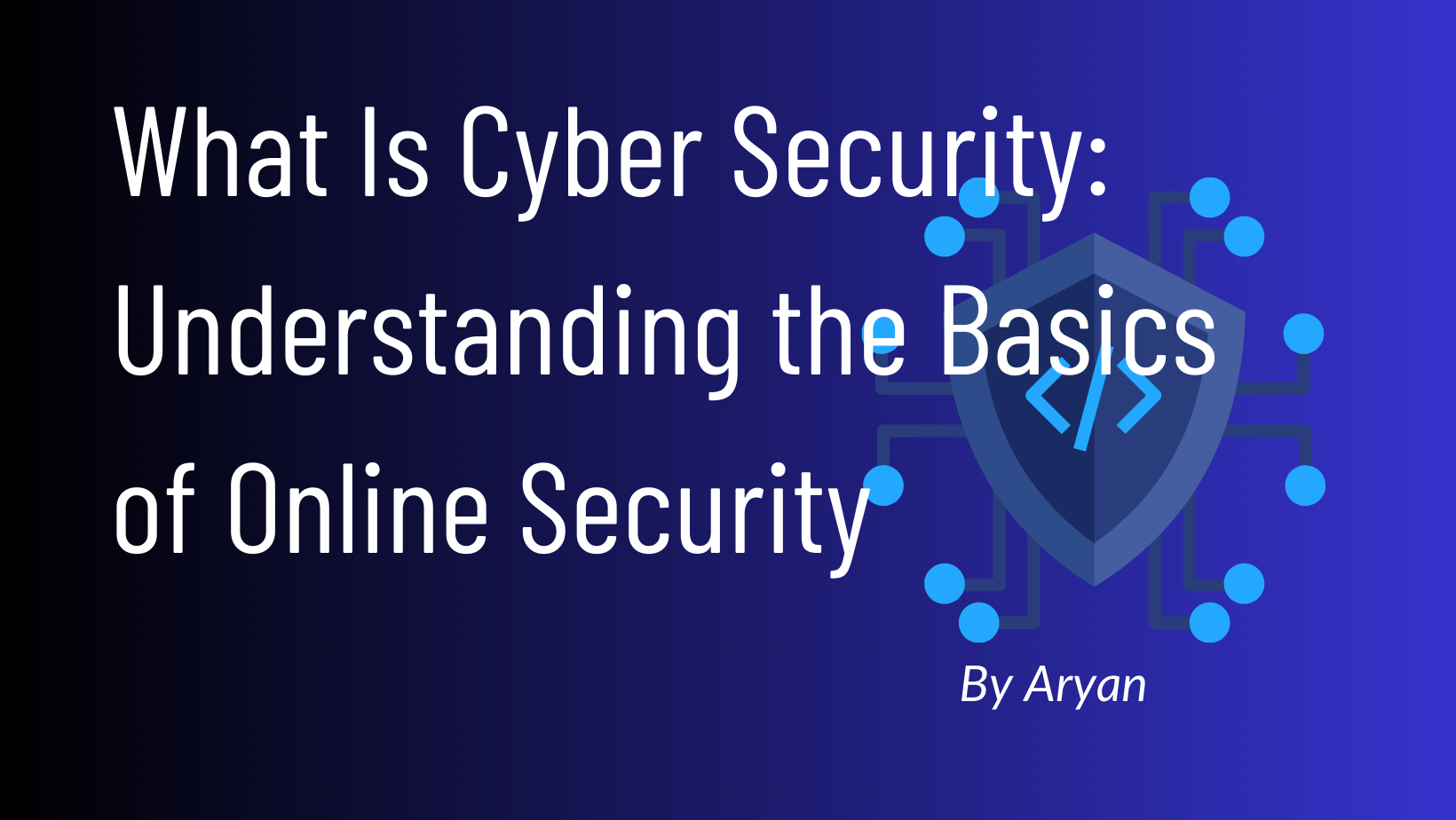What Is Cyber Security: Understanding the Basics of Online Security

Cybersecurity is the protection of internet-connected systems, including hardware, software, and data, from unauthorized access, theft, and damage. Cybersecurity has become an essential part of our daily lives since we are increasingly reliant on technology, which can make us vulnerable to cyber attacks. In this article, we will discuss the basics of cyber security, its importance, and how to keep yourself safe online.
Table of Contents
1. What is Cyber Security?
2. Why is Cyber Security Important?
3. Types of Cyber Attacks
4. Basic Elements of Cyber Security
· Confidentiality
· Integrity
· Availability
5. Cyber Security Threats and Vulnerabilities
· Malware
· Phishing
· Social Engineering
· Denial-of-Service (DoS)
6. Best Practices for Cyber Security
· Use Strong Passwords
· Keep Software Updated
· Use Anti-Virus and Anti-Malware Software
· Backup Your Data Regularly
· Be Cautious of Suspicious Emails and Websites
7. Cyber Security for Businesses
8. Conclusion
9. FAQs
What is Cyber Security?
Cybersecurity refers to the practice of protecting computers, servers, mobile devices, electronic systems, networks, and data from digital attacks. It involves a range of practices, technologies, and policies designed to secure computer networks and systems, prevent unauthorized access, and ensure data confidentiality, integrity, and availability.
Why is Cyber Security Important?
Cybersecurity is critical because cyber attacks can cause significant damage, such as financial loss, reputation damage, and loss of data or information. Cyber attacks can affect individuals, businesses, and governments, and can range from simple phishing scams to sophisticated cyber espionage campaigns.
Types of Cyber Attacks
There are many types of cyber attacks, and attackers can use a variety of methods to exploit vulnerabilities and gain unauthorized access to systems and data. Some of the most common types of cyber attacks include:
· Malware: Malware is malicious software that can infect computers and networks, steal sensitive data, and damage systems. Examples of malware include viruses, Trojans, and ransomware.
· Phishing: Phishing is a type of social engineering attack where attackers use fraudulent emails or websites to trick victims into giving away sensitive information, such as login credentials or credit card numbers.
· Social Engineering: Social engineering involves manipulating people into giving away sensitive information or performing actions that can compromise security. Examples of social engineering tactics include pretexting, baiting, and tailgating.
· Denial-of-Service (DoS): A DoS attack involves flooding a network or system with traffic or requests, causing it to crash or become unavailable. DoS attacks are often used to disrupt services or cause inconvenience to users.
Basic Elements of Cyber Security
There are three fundamental aspects of cyber security:
Confidentiality
Confidentiality refers to the protection of sensitive information from unauthorized access or disclosure. This involves measures such as encryption, access controls, and user authentication to ensure that only authorized individuals can access sensitive data.
Integrity
Integrity involves maintaining the accuracy and consistency of data over its lifecycle. This involves measures such as data backups, checksums, and digital signatures to ensure that data is not modified or tampered with without authorization.
Availability
Availability refers to the ability of systems and data to be accessed and used by authorized users when needed. This involves measures such as redundancy, fault tolerance, and disaster recovery to ensure that systems and data are always available when needed.
Cyber Security Threats and Vulnerabilities
Cybersecurity threats and vulnerabilities can arise from a variety of sources, including:
· Human error
· Software vulnerabilities
· Malware infections
· Phishing scams
· Social engineering attacks
· Insider threats
Malware, phishing, and social engineering attacks are some of the most common types of cyber threats that individuals and organizations face.
Malware
Malware is any malicious software that is designed to harm or disrupt computer systems, networks, or devices. Malware can be distributed in many ways, including through email attachments, infected websites, and removable media.
Malware can take many forms, including viruses, worms, Trojans, and ransomware. Viruses infect files and programs and spread when those files and programs are shared. Worms spread through networks and can infect many computers in a short amount of time. Trojans are malicious programs that are disguised as legitimate software, and ransomware is a type of malware that encrypts files and demands payment in exchange for the decryption key.
To protect against malware, it is essential to use anti-virus and anti-malware software, keep software and operating systems up-to-date, and avoid downloading or opening attachments from unknown sources.
Phishing
Phishing is a type of social engineering attack where an attacker sends a fraudulent email or message to trick the victim into revealing sensitive information such as passwords or credit card numbers. Phishing emails often look like legitimate emails from trusted sources such as banks or other financial institutions.
Phishing attacks can also take the form of fake websites that mimic legitimate sites to steal login credentials or other sensitive information. To protect against phishing attacks, it is essential to be cautious of unsolicited emails or messages and to verify the legitimacy of websites before entering sensitive information.
Social Engineering
Social engineering is the use of psychological manipulation to trick people into revealing sensitive information or performing actions that can compromise security. Social engineering tactics can include pretexting, baiting, and tailgating.
Pretexting involves creating a false pretext or story to gain access to sensitive information. Baiting involves leaving a physical or digital "bait" to entice the victim into performing an action such as clicking on a link or opening a file. Tailgating involves following someone into a restricted area without authorization.
To protect against social engineering attacks, it is essential to be cautious of unsolicited requests for sensitive information and to verify the identity of anyone who requests access to restricted areas.
Best Practices for Cyber Security
To protect against cyber threats, there are several best practices that individuals and organizations should follow:
Use Strong Passwords
Use strong passwords that are difficult to guess or crack. Passwords should be at least eight characters long and should include a mix of letters, numbers, and symbols. It is also essential to use unique passwords for each account and to change passwords regularly.
Keep Software Updated
Keep software and operating systems up-to-date to protect against vulnerabilities that can be exploited by attackers. Software updates often include security patches that address known vulnerabilities and improve system performance.
Use Anti-Virus and Anti-Malware Software
Use anti-virus and anti-malware software to protect against malware infections. Anti-virus and anti-malware software can detect and remove malicious software before it can cause damage.
Backup Your Data Regularly
Regularly backup your data to protect against data loss due to hardware failure or cyber attacks. Backups should be stored in a secure location and tested regularly to ensure that they can be restored if needed.
Be Cautious of Suspicious Emails and Websites
Be cautious of unsolicited emails or messages and avoid clicking on links or opening attachments from unknown sources. Also, be wary of websites that ask for sensitive information or that look suspicious.
Cyber Security for Businesses
Cybersecurity is also critical for businesses, which are increasingly reliant on technology and are prime targets for cyber attacks. Businesses can implement several measures to strengthen their cyber security:
Develop a Cyber Security Plan
Develop a comprehensive cyber security plan that outlines security policies and procedures, identifies potential threats and vulnerabilities, and establishes an incident response plan in case of a cyber attack.
Train Employees
Train employees on cyber security best practices and provide regular security awareness training. Employees should be aware of the risks and how to identify and report potential security incidents.
Implement Access Controls
Implement access controls to limit access to sensitive information and systems to authorized personnel only. This includes the use of strong passwords, multi-factor authentication, and role-based access controls.
Monitor Network Activity
Monitor network activity to detect potential threats and vulnerabilities. This includes implementing intrusion detection and prevention systems, logging network activity, and conducting regular vulnerability assessments.
Backup Data Regularly
Backup data regularly to protect against data loss due to cyber attacks or hardware failure. Backups should be stored in a secure location and tested regularly to ensure that they can be restored if needed.
Keep Software and Systems Up-to-Date
Keep software and systems up-to-date to protect against vulnerabilities that can be exploited by attackers. This includes patching software and operating systems, implementing security updates, and upgrading to more secure systems as needed.
Conclusion
Cyber security is an essential aspect of modern life and affects individuals and organizations alike. To protect against cyber threats, it is important to understand the different types of threats and best practices for staying safe online. By following best practices such as using strong passwords, keeping software up-to-date, and being cautious of suspicious emails and websites, individuals and organizations can reduce their risk of cyber attacks.
FAQs
1. What is the most common type of cyber attack?
The most common types of cyber attacks include malware infections, phishing scams, social engineering attacks, and insider threats.
2. How can I protect myself from cyber threats?
You can protect yourself from cyber threats by using strong passwords, keeping software up-to-date, and being cautious of suspicious emails and websites.
3. Why is cyber security important for businesses?
Cyber security is important for businesses because they are increasingly reliant on technology and are prime targets for cyber attacks. A cyber attack can result in data loss, financial loss, and damage to a company's reputation.
4. What should I do if I suspect a cyber attack?
If you suspect a cyber attack, you should immediately disconnect from the internet and contact your IT department or a cyber security professional.
5. How often should I backup my data?
You should backup your data regularly, at least once a week, and store backups in a secure location.
"Join the Cybersecurity Revolution Today! - Copyright © 2023 Aryan | Contact: support@asecurity.in - Follow us on Twitter @asecurityinfo"

